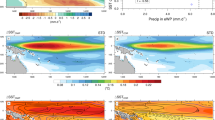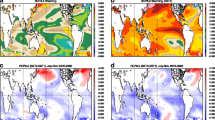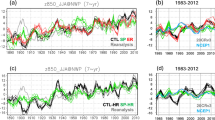Abstract
Sea surface temperature (SST) patterns both local to and remote from tropical cyclone (TC) development regions are important drivers of the variability of TC activity. Therefore, reliable simulations and predictions of TC activity depend on a realistic representation of tropical SST. Nevertheless, severe SST biases are common to the current generation of global climate models, especially in the tropical Pacific and Atlantic. These biases are strongly positive in the southeastern tropical basins, and negative, but weaker, in the northwestern tropical basins. To investigate the impact of the tropical SST biases on simulated TC activity, an atmospheric-only tropical channel model was used to conduct several sets of ensemble simulations. The simulations suggest an underrepresentation in Atlantic TC activity caused by the Atlantic cold bias alone, and an overrepresentation in Eastern North Pacific (ENP) TC activity due to the Atlantic cold bias and Pacific warm bias jointly. While the local impact of SST biases on TC activity is generally induced by the local anomalous SST and the associated changes in atmospheric conditions, the remote impact of the Atlantic bias on the ENP TCs is strongly driven by the change in topographically forced regional circulation. Moreover, an eastward shift in Western North Pacific TCs was generated by the Pacific SST biases, even though basin-wide TC activity indicators change insignificantly. The results indicate the importance of considering SST bias effects on simulated TC activity in climate model studies and highlight key regions where reducing SST biases could potentially improve TC representation in climate models.















Similar content being viewed by others
References
Bell GD, Halpert MS, Schnell RC et al (2000) Climate assessment for 1999. Bull Am Meteorol Soc 81:s1–s50. https://doi.org/10.1175/1520-0477(2000)81%5BS1:CAF%5D2.0.CO;2
Bender MA, Knutson TR, Tuleya RE et al (2010) Modeled impact of anthropogenic warming on the frequency of intense Atlantic hurricanes. Science 327:454–458. https://doi.org/10.1126/science.1180568
Biasutti M, Sobel AH, Kushnir Y (2006) AGCM precipitation biases in the tropical Atlantic. J Clim 19:935–958. https://doi.org/10.1175/JCLI3673.1
Blake ES, Rappaport EN, Jarrell JD et al (2007) The deadliest, costliest, and most intense United States tropical cyclones from 1851 to 2006 (and other frequently requested hurricane facts). NOAA/National Weather Service, National Centers for Environmental Prediction, National Hurricane Center Miami
Blake ES, Kimberlain TB, Berg RJ et al (2013) Tropical cyclone report hurricane Sandy. National Hurricane Center 12: 1–10
Camargo SJ (2013) Global and regional aspects of tropical cyclone activity in the CMIP5 models. J Clim 26:9880–9902. https://doi.org/10.1175/JCLI-D-12-00549.1
Camargo SJ, Hsiang SM (2016) From the influence of climate to their socioeconomic impacts. In: Tropical cyclones, pp 303–342
Camargo SJ, Sobel AH (2005) Western North Pacific tropical cyclone intensity and ENSO. J Clim 18:2996–3006. https://doi.org/10.1175/JCLI3457.1
Camargo SJ, Emanuel KA, Sobel AH (2007) Use of a genesis potential index to diagnose ENSO effects on tropical cyclone genesis. J Clim 20:4819–4834. https://doi.org/10.1175/JCLI4282.1
Chan JCL (1985) Tropical cyclone activity in the Northwest Pacific in relation to the El Niño/Southern Oscillation phenomenon. Mon Weather Rev 113:599–606. https://doi.org/10.1175/1520-0493(1985)113%3C0599:TCAITN%3E2.0.CO;2
Chan JCL (2005) Interannual and interdecadal variations of tropical cyclone activity over the western North Pacific. Meteorol Atmos Phys 89:143–152. https://doi.org/10.1007/s00703-005-0126-y
Colas F, McWilliams JC, Capet X, Kurian J (2012) Heat balance and eddies in the Peru-Chile current system. Clim Dyn 39:509–529. https://doi.org/10.1007/s00382-011-1170-6
Ding H, Keenlyside NS, Latif M (2012) Impact of the equatorial Atlantic on the El Niño Southern Oscillation. Clim Dyn 38:1965–1972. https://doi.org/10.1007/s00382-011-1097-y
Emanuel KA (2005) Increasing destructiveness of tropical cyclones over the past 30 years. Nature 436:686–688. https://doi.org/10.1038/nature03906
Emanuel KA (2007) Environmental factors affecting tropical cyclone power dissipation. J Clim 20:5497–5509. https://doi.org/10.1175/2007JCLI1571.1
Emanuel KA (2017) Assessing the present and future probability of Hurricane Harvey’s rainfall. Proc Natl Acad Sci 114:12681–12684. https://doi.org/10.1073/pnas.1716222114
Emanuel KA, Nolan DS (2004) Tropical cyclone activity and the global climate system. In: 26th conference on hurricanes and tropical meteorology. American Meteorological Society, Miami, FL
Graham NE, Barnett TP (1987) Sea surface temperature, surface wind divergence, and convection over tropical oceans. Science 238:657–659. https://doi.org/10.1126/science.238.4827.657
Gray WM (1984a) Atlantic seasonal hurricane frequency. Part II: forecasting its variability. Mon Weather Rev 112:1669–1683. https://doi.org/10.1175/1520-0493(1984)112%3C1669:ASHFPI%3E2.0.CO;2
Gray WM (1984b) Atlantic seasonal hurricane frequency. Part I: El Niño and 30 mb Quasi-Biennial Oscillation influences. Mon Weather Rev 112:1649–1668. https://doi.org/10.1175/1520-0493(1984)112%3C1649:ASHFPI%3E2.0.CO;2
Ham Y-G, Kug J-S, Park J-Y (2013a) Two distinct roles of Atlantic SSTs in ENSO variability: North tropical Atlantic SST and Atlantic Niño. Geophys Res Lett 40:4012–4017. https://doi.org/10.1002/grl.50729
Ham Y-G, Kug J-S, Park J-Y, ** F-F (2013b) Sea surface temperature in the north tropical Atlantic as a trigger for El Niño/Southern Oscillation events. Nat Geosci 6:112–116. https://doi.org/10.1038/ngeo1686
Holland GJ, Webster PJ (2007) Heightened tropical cyclone activity in the North Atlantic: natural variability or climate trend? Philos Trans R Soc A Math Phys Eng Sci 365:2695–2716. https://doi.org/10.1098/rsta.2007.2083
Jien JY, Gough WA, Butler K (2015) The influence of El Niño–Southern Oscillation on tropical cyclone activity in the eastern North Pacific basin. J Clim 28:2459–2474. https://doi.org/10.1175/JCLI-D-14-00248.1
** F-F, Boucharel J, Lin I-I (2014) Eastern Pacific tropical cyclones intensified by El Niño delivery of subsurface ocean heat. Nature 516:82–85. https://doi.org/10.1038/nature13958
Kanamitsu M, Ebisuzaki W, Woollen J et al (2002) NCEP–DOE AMIP-II Reanalysis (R-2). Bull Am Meteorol Soc 83:1631–1644. https://doi.org/10.1175/BAMS-83-11-1631
Klotzbach PJ, Bowen SG, Pielke R, Bell M (2018) Continental United States hurricane landfall frequency and associated damage: observations and future risks. Bull Am Meteorol Soc BAMS-D-17-0184.1. https://doi.org/10.1175/BAMS-D-17-0184.1
Knutson T, Landsea C, Emanuel K (2010) Tropical cyclones and climate change: a review. In: Chan JCL, Kepert J (eds) Global perspectives on tropical cyclones. World Scientific, Singapore, pp 243–286
Kucharski F, Parvin A, Rodriguez-Fonseca B et al (2016) The teleconnection of the tropical Atlantic to Indo-Pacific sea surface temperatures on inter-annual to centennial time scales: A review of recent findings. Atmosphere (Basel) 7:29. https://doi.org/10.3390/atmos7020029
LaRow TE, Stefanova L, Shin D-W, Cocke S (2010) Seasonal Atlantic tropical cyclone hindcasting/forecasting using two sea surface temperature datasets. Geophys Res Lett 37:L02804. https://doi.org/10.1029/2009GL041459
Li G, **e S-P (2012) Origins of tropical-wide SST biases in CMIP multi-model ensembles. Geophys Res Lett 39:L22703. https://doi.org/10.1029/2012GL053777
Lin I-I, Black P, Price JF et al (2013) An ocean coupling potential intensity index for tropical cyclones. Geophys Res Lett 40:1878–1882. https://doi.org/10.1002/grl.50091
Liu H, Wang C, Lee S-K, Enfield D (2012) Atlantic warm-pool variability in the IPCC AR4 CGCM simulations. J Clim 25:5612–5628. https://doi.org/10.1175/JCLI-D-11-00376.1
Masunaga H, Nakajima TY, Nakajima T et al (2002) Physical properties of maritime low clouds as retrieved by combined use of tropical rainfall measuring mission (TRMM) microwave imager and visible/infrared scanner 2. Climatology of warm clouds and rain. J Geophys Res 107:4367. https://doi.org/10.1029/2001JD001269
Murakami H, Vecchi GA, Villarini G et al (2016) Seasonal forecasts of major hurricanes and landfalling tropical cyclones using a high-resolution GFDL coupled climate model. J Clim 29:7977–7989. https://doi.org/10.1175/JCLI-D-16-0233.1
Nobre P, Shukla J (1996) Variations of sea surface temperature, wind stress, and rainfall over the tropical Atlantic and South America. J Clim 9:2464–2479. https://doi.org/10.1175/1520-0442(1996)009<2464:VOSSTW>2.0.CO;2
Painemal D, Minnis P (2012) On the dependence of albedo on cloud microphysics over marine stratocumulus clouds regimes determined from Clouds and the Earth’s Radiant Energy System (CERES) data. J Geophys Res Atmos 117:D06203. https://doi.org/10.1029/2011JD017120
Patricola CM, Li M, Xu Z et al (2012) An investigation of tropical Atlantic bias in a high-resolution coupled regional climate model. Clim Dyn 39:2443–2463. https://doi.org/10.1007/s00382-012-1320-5
Patricola CM, Saravanan R, Chang P (2014) The impact of the El Niño–Southern Oscillation and Atlantic Meridional Mode on seasonal Atlantic tropical cyclone activity. J Clim 27:5311–5328. https://doi.org/10.1175/JCLI-D-13-00687.1
Patricola CM, Chang P, Saravanan R (2016) Degree of simulated suppression of Atlantic tropical cyclones modulated by flavour of El Niño. Nat Geosci 9:155–160. https://doi.org/10.1038/ngeo2624
Patricola CM, Saravanan R, Chang P (2017) A teleconnection between Atlantic sea surface temperature and eastern and central North Pacific tropical cyclones. Geophys Res Lett 44:1167–1174. https://doi.org/10.1002/2016GL071965
Polo I, Martin-Rey M, Rodriguez-Fonseca B et al (2015) Processes in the Pacific La Niña onset triggered by the Atlantic Niño. Clim Dyn 44:115–131. https://doi.org/10.1007/s00382-014-2354-7
Rayner NA, Parker DE, Horton EB et al (2003) Global analyses of sea surface temperature, sea ice, and night marine air temperature since the late nineteenth century. J Geophys Res 108:4407. https://doi.org/10.1029/2002JD002670
Reed A, Mann M, Emanuel K, Titley D (2015) An analysis of long-term relationships among count statistics and metrics of synthetic tropical cyclones downscaled from CMIP5 models. J Geophys Res Atmos 120:7506–7519. https://doi.org/10.1002/2015JD023357
Reynolds RW, Smith TM, Liu C et al (2007) Daily high-resolution-blended analyses for sea surface temperature. J Clim 20:5473–5496. https://doi.org/10.1175/2007JCLI1824.1
Richter I (2015) Climate model biases in the eastern tropical oceans: causes, impacts and ways forward. Wiley Interdiscip Rev Clim Chang 6:345–358. https://doi.org/10.1002/wcc.338
Richter I, **e S-P (2008) On the origin of equatorial Atlantic biases in coupled general circulation models. Clim Dyn 31:587–598. https://doi.org/10.1007/s00382-008-0364-z
Rodríguez-Fonseca B, Polo I, García-Serrano J et al (2009) Are Atlantic Niños enhancing Pacific ENSO events in recent decades? Geophys Res Lett 36:L20705. https://doi.org/10.1029/2009GL040048
Shuckburgh E, Mitchell D, Stott P (2017) Hurricanes Harvey, Irma and Maria: how natural were these ‘natural disasters’? Weather 72:353–354. https://doi.org/10.1002/wea.3190
Skamarock WC, Klemp JB, Dudhia J et al (2008) A description of the advanced research WRF version 3NCAR/TN–475+STR. https://doi.org/10.5065/D68S4MVH.
Small RJ, Curchitser E, Hedstrom K et al (2015) The Benguela upwelling system: quantifying the sensitivity to resolution and coastal wind representation in a global climate model. J Clim 28:9409–9432. https://doi.org/10.1175/JCLI-D-15-0192.1
Taylor KE, Stouffer RJ, Meehl GA (2012) An overview of CMIP5 and the experiment design. Bull Am Meteorol Soc 93:485–498. https://doi.org/10.1175/BAMS-D-11-00094.1
Toniazzo T, Mechoso CR, Shaffrey LC, Slingo JM (2010) Upper-ocean heat budget and ocean eddy transport in the south-east Pacific in a high-resolution coupled model. Clim Dyn 35:1309–1329. https://doi.org/10.1007/s00382-009-0703-8
Tory KJ, Chand S, McBride J, Ye H, Dare R (2013) Projected changes in Late-twenty-first-century tropical cyclone frequency in 13 coupled climate models from phase 5 of the coupled model intercomparison project. J Clim 26:9946–9959. https://doi.org/10.1175/JCLI-D-13-00010.1
Vecchi GA, Delworth T, Gudgel R et al (2014) On the seasonal forecasting of regional tropical cyclone activity. J Clim 27:7994–8016. https://doi.org/10.1175/JCLI-D-14-00158.1
Vimont DJ, Kossin JP (2007) The Atlantic meridional mode and hurricane activity. Geophys Res Lett 34:L07709. https://doi.org/10.1029/2007GL029683
Walsh K (1997) Objective detection of tropical cyclones in high-resolution analyses. Mon Weather Rev 125:1767–1779. https://doi.org/10.1175/1520-0493(1997)125%3C1767:ODOTCI%3E2.0.CO;2
Wang B, Chan JCL (2002) How strong ENSO events affect tropical storm activity over the western North Pacific. J Clim 15:1643–1658. https://doi.org/10.1175/1520-0442(2002)015%3C1643:HSEEAT%3E2.0.CO;2
Wang C, Lee S-K (2009) Co-variability of tropical cyclones in the North Atlantic and the eastern North Pacific. Geophys Res Lett 36:L24702. https://doi.org/10.1029/2009GL041469
Wang B, Li T (1993) A simple tropical atmosphere model of relevance to short-term climate variations. J Atmos Sci 50:260–284. https://doi.org/10.1175/1520-0469(1993)050%3C0260:ASTAMO%3E2.0.CO;2
Wang C, Li C, Mu M, Duan W (2013) Seasonal modulations of different impacts of two types of ENSO events on tropical cyclone activity in the western North Pacific. Clim Dyn 40:2887–2902. https://doi.org/10.1007/s00382-012-1434-9
Wang C, Zhang L, Lee S-K et al (2014) A global perspective on CMIP5 climate model biases. Nat Clim Chang 4:201–205. https://doi.org/10.1038/nclimate2118
Webster PJ, Holland GJ, Curry JA, Chang H-R (2005) Changes in tropical cyclone number, duration, and intensity in a warming environment. Science 309:1844–1846. https://doi.org/10.1126/science.1116448
Whitney LD, Hobgood JS (1997) The relationship between sea surface temperatures and maximum intensities of tropical cyclones in the eastern North Pacific ocean. J Clim 10:2921–2930. https://doi.org/10.1175/1520-0442(1997)010%3C2921:TRBSST%3E2.0.CO;2
Whyte FS, Taylor MA, Stephenson TS, Campbell JD (2008) Features of the Caribbean low level jet. Int J Climatol 28:119–128. https://doi.org/10.1002/joc.1510
Xu Z, Chang P, Richter I et al (2014a) Diagnosing southeast tropical Atlantic SST and ocean circulation biases in the CMIP5 ensemble. Clim Dyn 43:3123–3145. https://doi.org/10.1007/s00382-014-2247-9
Xu Z, Li M, Patricola CM, Chang P (2014b) Oceanic origin of southeast tropical Atlantic biases. Clim Dyn 43:2915–2930. https://doi.org/10.1007/s00382-013-1901-y
Yu J-Y, Kao P, Paek H et al (2015) Linking emergence of the Central Pacific El Niño to the Atlantic Multidecadal Oscillation. J Clim 28:651–662. https://doi.org/10.1175/JCLI-D-14-00347.1
Zhang L, Wang C, Song Z, Lee S-K (2014) Remote effect of the model cold bias in the tropical North Atlantic on the warm bias in the tropical southeastern Pacific. J Adv Model Earth Syst 6:1016–1026. https://doi.org/10.1002/2014MS000338
Zhang W, Vecchi GA, Villarini G et al (2017) Modulation of western North Pacific tropical cyclone activity by the Atlantic Meridional Mode. Clim Dyn 48:631–647. https://doi.org/10.1007/s00382-016-3099-2
Zhao M, Held IM, Vecchi GA (2010) Retrospective forecasts of the hurricane season using a global atmospheric model assuming persistence of SST anomalies. Mon Weather Rev 138:3858–3868. https://doi.org/10.1175/2010MWR3366.1
Zuidema P, Chang P, Medeiros B et al (2016) Challenges and prospects for reducing coupled climate model SST biases in the eastern tropical Atlantic and Pacific Oceans: The U.S. CLIVAR eastern tropical oceans synthesis working group. Bull Am Meteorol Soc 97:2305–2328. https://doi.org/10.1175/BAMS-D-15-00274.1
Landsea CW, Franklin JL, Beven JL (2015) The revised Atlantic hurricane database (HURDAT2). United States National Oceanic and Atmospheric Administration’s National Weather Service
Acknowledgements
The authors wish to thank the editor and two anonymous reviewers for comments that greatly improved the quality of this paper. This research is supported by U.S. National Science Foundation Grants OCE-1334707, AGS-1347808 and AGS-1462127, and National Oceanic and Atmospheric Administration Grant NA13OAR4310136. PC acknowledges the Natural Science Foundation of China (41490644 and 41490640). C.M.P. acknowledges support from the U.S. Department of Energy, Office of Science, Office of Biological and Environmental Research, Climate and Environmental Sciences Division, Regional & Global Climate Modeling Program, under Award Number DE-AC02-05CH11231. High-performance computing resources provided by the Extreme Science and Engineering Discovery Environment (XSEDE). Simulations were performed at the Texas Advanced Computing Center (TACC) at the University of Texas at Austin and the Texas A&M Supercomputing Facility.
Author information
Authors and Affiliations
Corresponding author
Additional information
Publisher’s Note
Springer Nature remains neutral with regard to jurisdictional claims in published maps and institutional affiliations.
Rights and permissions
About this article
Cite this article
Hsu, WC., Patricola, C.M. & Chang, P. The impact of climate model sea surface temperature biases on tropical cyclone simulations. Clim Dyn 53, 173–192 (2019). https://doi.org/10.1007/s00382-018-4577-5
Received:
Accepted:
Published:
Issue Date:
DOI: https://doi.org/10.1007/s00382-018-4577-5




